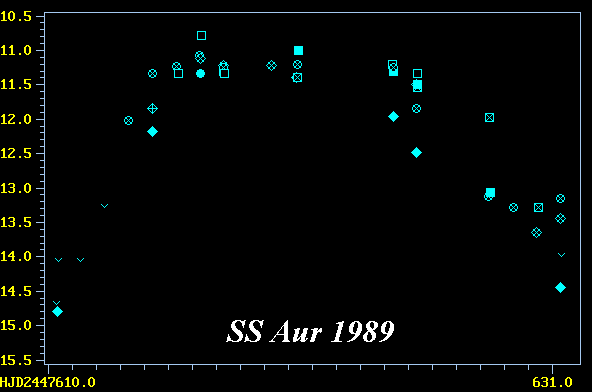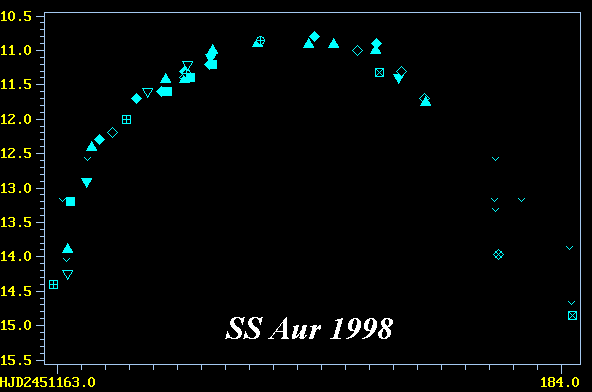

The mixed spell of weather that prevailed over the UK during the period December to February produced an unusually large number of clear, and partly clear, nights (compared to normal weather patterns for winter months), and this coincided with good activity in several bright dwarf novae. U Gem had a long outburst just before Christmas, and was followed almost continuously from when it rose above magnitude 13.8 on the 10th December, until it dipped below the same brightness 16 days later. SU UMa commenced rising to a supermaximum on the 6th January, and did not fade back to normal minimum until the 21st January. The rise to maximum was interrupted by a brief mini-fade of 0.2 magnitude which resembled the onset of the 3 day oscillations previously reported for this star.
The most interesting activity occurred, however, in SS Aur, which produced an unusually long outburst in the second half of December and took an extraordinarily long time to reach maximum. The star was caught rising on the 15th December, and had reached magnitude 12.5 by the following night. The rate of rise then slowed down significantly and it took a further 8 days to finally reach a maximum magnitude of 10.9. The width of the outburst was measured at 13 days above magnitude 12.0, which equals the longest outburst previously recorded by the VSS, which was in March/April 1989. The AAVSO however, have reported two longer outbursts, each lasting 14 days above magnitude 12.0. These occurred in May/June 1916, and September 1942, when most of our observers were otherwise engaged (the battle of Jutland was underway and preparations were being made for the Somme and El Alamein offensives), and the VSS only partly observed the second one.
Light curves of the 1989 and 1998 outbursts are shown for comparison.


Both outbursts lasted 18 days above magnitude 14.0, but their shapes are very different. The 1989 outburst was similar to a normal long outburst with a rapid rise and much slower fade, whilst that of 1998 was pretty much a mirror image of 1989. VSS data accrued on SS Aur indicates a mean period of 51 days between outbursts, but the 1998/99 apparition has been quite eventful so far. In October there was a normal short outburst, which was followed 33 days later by an anomalous outburst. Then came the December event, followed just 37days later by another rather faint anomalous outburst. The average interval between outbursts so far this apparition, has been 37 days. The star has also been rather bright (around magnitude 14.5) at times in-between the outbursts. SS Aur has in the past (in 1929/29, 1970/71 and 1983) shown rapid erratic variations but the present activity is more akin to speeded up normal behavior.
It will be interesting to see how long the current active state will continue and observers are urged to continue monitoring the star throughout the spring and summer months as long as possible. It is worth reminding observers that important estimates can be secured during the months of June and July from our latitude. If you can see Capella and are equipped with an 8" telescope it is possible to see comparison L (12.6) throughout these twilight-ridden months. Although SS Aur has been followed for over 90 years now, it continues to surprise and reward the visual observer.